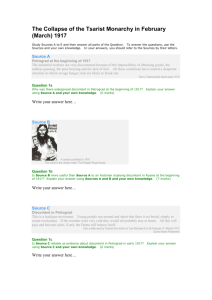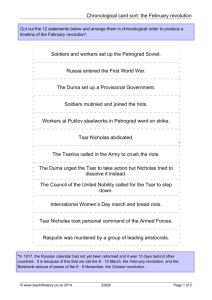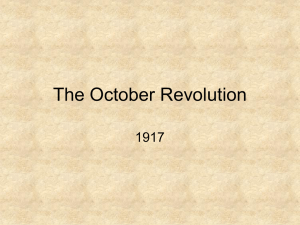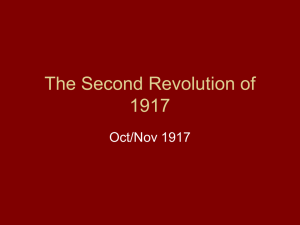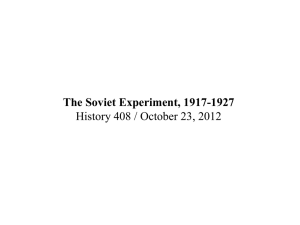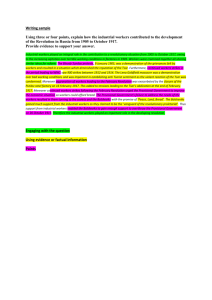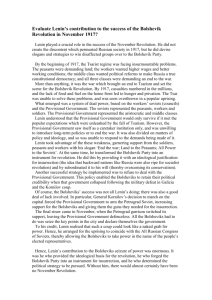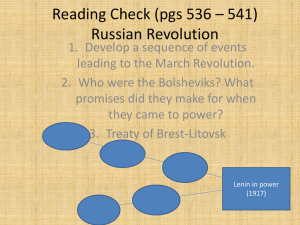File
advertisement
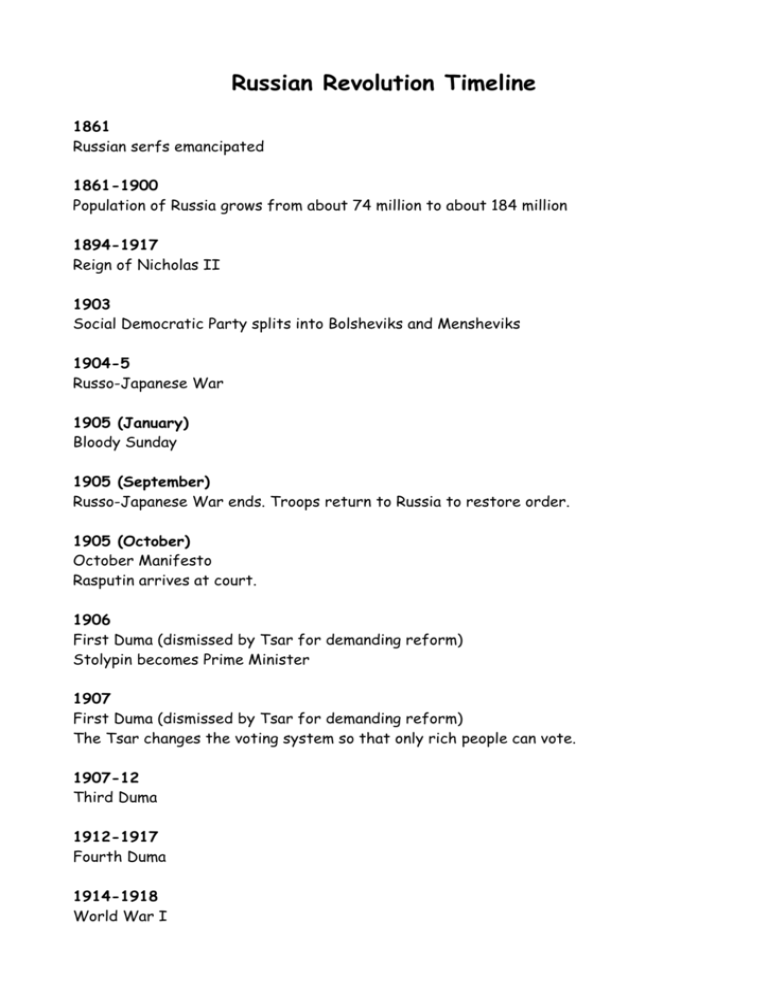
Russian Revolution Timeline 1861 Russian serfs emancipated 1861-1900 Population of Russia grows from about 74 million to about 184 million 1894-1917 Reign of Nicholas II 1903 Social Democratic Party splits into Bolsheviks and Mensheviks 1904-5 Russo-Japanese War 1905 (January) Bloody Sunday 1905 (September) Russo-Japanese War ends. Troops return to Russia to restore order. 1905 (October) October Manifesto Rasputin arrives at court. 1906 First Duma (dismissed by Tsar for demanding reform) Stolypin becomes Prime Minister 1907 First Duma (dismissed by Tsar for demanding reform) The Tsar changes the voting system so that only rich people can vote. 1907-12 Third Duma 1912-1917 Fourth Duma 1914-1918 World War I 1914 Russian forces badly beaten at the battles of Tannenberg and the Masurian Lakes 1915 Nicholas II dismisses his commander in chief and takes personal command of the army, leaving the Tsarina in charge in Petrograd. 1916 Brusilov offensive fails. Over a million Russian soldiers are killed. Rasputin is assassinated 1916-17 Particularly bad winter in Russia. 1917 (March 7/February 22) Lockout at Putilov Steel works puts 22,000 steelworkers on the streets of Petrograd. Other workers strike in sympathy. 1917 (March 8/February 23) International Women’s Day march turns into a demonstration. The women are joined by striking workers. 1917 (March 9-10/February 24-25) Increasing protests in Petrograd. 250,000 workers on strike (half the workforce). Telegram from Tsarina to Tsar, March 10 “This is a hooligan movement. Young people run and shout that there is no bread, simply to create excitement, along with workers who prevent others from working. If the weather were very cold they would probably stay at home, But all this will pass and become calm, if only the Duma will behave itself. “ Telegram from Tsar to General Khabalov, in command of the army in Petrograd, March 10 “I command you to suppress from tomorrow all disorders on the streets of the capital, which are impermissible at a time when the fatherland is carrying on a difficult war with Germany.” The Tsar orders troops to shoot at the demonstrators. 1917 (March 11/ February 26) Troops fire on the crowds killing about 40 people. The President of the Duma urges the Tsar to form a new government. Telegram from Rodzianko, President of the Duma to the Tsar, March 11 “The situation is serious. There is anarchy in the capital. The government is paralysed. It is necessary immediately to entrust a person who enjoys the confidence of the country with the formation of the government. Any delay is equivalent to death. I pray God that in this hour responsibility will not fall upon the sovereign.” The Tsar Dissolves the Duma. 1917 (March 12/February 27) Soldiers mutiny, refusing to shoot the protesters. Telegram from Rodzianko, President of the Duma to the Tsar, March 12 “The situation is growing worse. Measures must be adopted immediately, because tomorrow will be too late. The last hour has come, when the fate of the fatherland and the dynasty is being decided.” Nicholas II in speech with Count Fredericks, March 12 “This fat Rodzianko has written me some nonsense, to which I will not reply.” The Duma forms the Provisional Government. Petrograd Soviet forms. 1917 (March 13/February 28) Tsar sets out for Petrograd. 1917 (March 14/March 1) Generals tell Tsar that the army cannot support him. Petrograd Soviet Issues Order Number 1 1917 (March 15/March 2) Tsar Nicholas abdicates in favour of his brother, who refuses the crown. 1917 (April) Lenin returns to Russia and issues his April Theses. 1917 (May) Kerensky becomes Minster for War and the dominant figure in the Provisional Government. 1917 (June) Kerensky orders the army to launch an offensive, which fails. 1917 (July) Trotsky (formerly a Menshevik) joins the Bolsheviks. Bolshevik uprising fails. Many Bolsheviks arrested. Lenin flees to Finland. Kerensky becomes Prime Minister 1917 (August) Kornilov Affair; Bolsheviks get a majority in the Petrograd Soviet for the first time. 1917 (September) Bolshevik majority in Moscow Soviet Bolshevik Central Committee rejects Lenin’s first call for insurrection. Trotsky becomes Chairman of the Petrograd Soviet 1917 (November 6-7/October 24-25) October Revolution- Bolsheviks seize power. Bolshevik Revolution Oct/November 1917 Oct 20/7 Lenin returns to Petrograd Oct 22/9 In response to rumours that Kerensky was planning to abandon Petrograd to the Germans (started by his attempt to move the radical army units away from the city), the Bolsheviks set up a Military Revolutionary Committee Oct 23/10 Bolshevik Central Committee agrees to seize power. (Kamenev and Zinoviev vote against it.) Oct 29/16 Trotsky persuades Central Committee to wait until the eve of the AllRussian Congress of Soviets Nov 3/Oct 21 Regimental committee of the Petrograd garrison agrees to accept authority of the military revolutionary committee; Thousands of rifles distributed to Red Guards Nov 5/Oct 23 Trotsky wins over troops of Peter and Paul fortress; 100,000 rifles for Red Guards Nov 6/Oct 24 Kerensky closes two Bolshevik newspapers Kerensky orders cruiser Aurora (close to the Winter Palace) to put to sea Trotsky re-opens newspapers and countermands the order to the cruiser Aurora Bolshevik headquarters, (Smolny Institute) fortified Red Guards and soldiers take key positions – stations, telephone exchanges, post offices, national bank, Tauride palace. Nov 7/Oct 25 Kerensky borrows a car from the American Embassy and drives to the front in search of loyal troops. Pre- Parliament forcibly dispersed by Bolsheviks Lenin and Trotsky declare to the Petrograd Soviet that a new Soviet government will be formed. Red Guards and soldiers, helped by the Aurora, storm the Winter Palace and arrest the Provisional government (defended only by cadets and a woman’s battalion) All-Russian Congress of Soviets assembles at Smolny. Although there were 399 Bolsheviks out of 670 members, it was not guaranteed that they would support the revolution, since some Bolsheviks weren’t convinced. The Mensheviks and moderate SRs walked out to protest against the revolution, leaving the Bolsheviks and left SRs in control. As thy left, Trotsky shouted “You are bankrupt. You have played out your role. Go where you belong: to the dust heap of history.” 1917 (November 7/October 25) All Russian Congress of Soviets meets. Mensheviks and SRs storm out in protest, leaving Bolsheviks and Left SRs in charge. 1917 (November 8/October 26) Commander of Northern Front refuses to give Kerensky troops to assault Petrograd. General Krasov offers 700 Cossacks All Russian Congress of Soviets elects Council of People’s Commissars and passes the Decree on Peace and the Decree on Land. 1917 (October-December/November-December) Central Executive Committee of All Russian Congress of Soviets elected (2/3 Bolshevik) All Russian Congress of Soviets gives control of factories to committees of workers. All Russian Congress of Soviets sets up the CHEKA. Bolsheviks crush an uprising by military cadets. Bolsheviks drive off Cossack assault on Petrograd. 1917 (November) Elections for Constituent Assembly held. Party Socialist Revolutionaries Bolsheviks Kadets Mensheviks Others Percentage of Vote 53% 24% 5% 3% 15% 1918 (January 5) Constituent Assembly meets for the first and last time, before being disbanded by Red Guards (including sailors from the Kronstadt Naval Base) 1918 (March 3) Treaty of Brest Litovsk 1918-21 Civil War 1921 Famine 1921 (March) Kronstadt Mutiny Lenin introduces the New Economic Policy 1922 Lenin has two strokes. 1923 Lenin has a third stroke that leaves him unable to speak. 1924 (January) Lenin dies.

